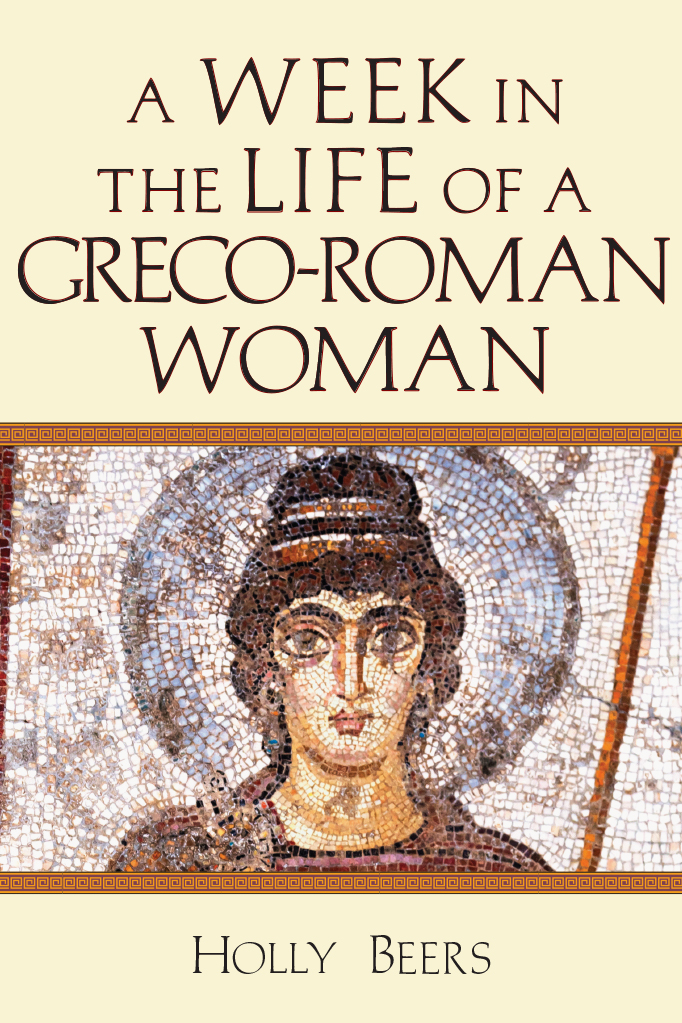Holly Beers: A Week in the Life of a Greco-Roman Woman
 Holly Beers, A Week in the Life of a Greco-Roman Woman (Downers Grove, IL: IVP Academic, 2019), 172 pp.
Holly Beers, A Week in the Life of a Greco-Roman Woman (Downers Grove, IL: IVP Academic, 2019), 172 pp.
A Week in the Life of a Greco-Roman Woman is the sixth book in A Week in the Life Series from InterVarsity Press. Previously published are: A Week in the Life of Corinth, A Roman Centurion, Fall of Jerusalem, Rome, and A Slave. These books attempt to combine historical fiction with historical and archaeological data. Dr. Holly Beers, Associate Professor of Religious Studies at Westmont College, is eminently qualified because of her doctorate in New Testament and past studies in the gospels (The Followers of Jesus as the Servant). She is also a member of the Society for Pentecostal Studies, Institute for Biblical Research, Society of Biblical Literature, and Evangelical Theological Society. Her portrayal of the Greco-Roman life is commensurate with the historical and archaeological data that we have.
The concept for the series is a creative one, aimed to reach a larger audience with the story of the early church. Greco-Roman Woman is the story of Anthia, wife of Philetus, a fisherman in Ephesus, during the early first century period when Paul, Priscilla, Aquila, and Timothy are ministering in Ephesus (Acts 19; c. AD 53-55). Unlike many historical studies of the past, Beers mainly highlights the lives of the poor and of women, those who lived day by day for their “daily bread.” She begins with a delivery of a stillborn baby that results in the death of the mother, Dorema, Anthia’s friend (Prologue). Then a regular day is catalogued in a fisher family’s life (day 1); the pregnant Anthia’s onset of her own bleeding (day 2), a neighbor’s (Lampo) son Euxinus’s suffering from fever, while not being healed by idols Asclepius or Artemis, but by Jesus (day 3); Anthia shopping for food in the agora (while she still bleeds) (day 4); Anthia discovering her husband Philetus visiting a prostitute while she herself attends a Christian service led by Paul and Priscilla, where Anthia is healed (day 5); a Christian (Epaenetus) leading the other Christians in publicly burning his expensive magic books (day 6); ending on a rainy day with Anthia’s summary thoughts about the generosity of the Christians, the healed fetus, but the anger of her husband (day 7). The book ends with Anthia asking herself if she should “transfer” her loyalty to “Jesus and the Way? What about Philetus—his honor and his anger—if he discovers me? What might this cost me?” (166). It was a very full week.
Beers presents a beautiful picture of the Christians and Christianity: equality between male and female, rich and poor, slave and free.
But, in contrast, Beers presents a beautiful picture of the Christians and Christianity. She portrays an attractive picture of Christian equality between male and female, rich and poor, slave and free (e.g., 124). Worship at Ephesus is described from 1 Corinthians 14:26 where “everyone contributes” (123). The Christians by prayer (and by handkerchief!) (see Acts 19:12) heal all who ask. The poor are assisted by the wealthy Christians with a generosity of food and employment opportunities (e.g., 164). Paul asks Priscilla to help with communion (120).
The intention to combine historical fiction with archaeological and historical data is not always successful, in my opinion. Some of the previous authors in the Week in the Life Series used footnotes and others used inserts of explanatory text. In Greco-Roman Woman, the data is inserted periodically throughout the chapter. I found the nonfictional data intrusive in the narrative. In addition, the narrative does not provide a clear portrayal of the characters. The plot does not sweep the reader along. Eventually, I read the inserts at the end of each chapter so as not to break up the narrative flow. The value of Greco-Roman Woman is it provides the reader with a feeling for everyday ancient first century life so that we learn in narrative form about the life of a poor woman in Ephesus who is beginning to learn about Christianity. What were her costly challenges in becoming a Christian? Beers has done much research to present to the twenty-first century reader the challenges and differences of living in the first century. For all Beer’s research, we should be most thankful.
Reviewed by Aída Besançon Spencer
Publisher’s Page: https://www.ivpress.com/a-week-in-the-life-of-a-greco-roman-woman
Category: Biblical Studies, Spring 2020


